Stem cells and epigenetics
1/63
There's no tags or description
Looks like no tags are added yet.
Name | Mastery | Learn | Test | Matching | Spaced |
|---|
No study sessions yet.
64 Terms
After a human zygote undergoes 3 complete cell cycles and consists of 8 identical cells each of these cells is said to be totipotent. What is a totipotent cell?
A cell that can develop into a complete human being
Complete the sentence:
In most animals, fertilisation is followed by a series of rapid cell _______. In these first few divisions, the embryo divides without _______ in size. _______ cells are produced with each successive division. Large reserves of _______ and extra cell contents that eggs _________ allow the zygote to divide rapidly soon after ________.
In most animals, fertilisation is followed by a series of rapid cell divisions. In these first few divisions, the embryo divides without growing in size. Smaller cells are produced with each successive division. Large reserves of nutrients and extra cell contents that eggs accumulate allow the zygote to divide rapidly soon after fertilisation.
What is the blastocyst and how many days after contraception is it formed? What does it go on to form? What is pluripotent embryonic stem cells?
A hollow ball of cells formed 5 days after conception. The outer blastocyst cell layer goes on to form the placenta. The inner cell mass of around 50 cells goes on to form the tissues of the developing embryo - pluripotent embryonic stem cells.
What can pluripotent stem cells do and what can they not do?
Potentially give rise to most cell types, but not all 216 that make up an adult human body.
Complete the sentence:
As the embryo develops into a ——cellular body, the cells from which it is made become increasingly ___________. Most of them lose capacity to develop into a wide range of cells. Instead, they become increasingly __________.
As the embryo develops into a multicellular body, the cells from which it is made become increasingly differentiated. Most of them lose capacity to develop into a wide range of cells. Instead, they become increasingly specialised.
What are multipotent stem cells? - adult stem cells
Cells which retain a certain capacity to give rise to a variety of different cell types.
True or false many plant cells remain totipotent throughout the life of the plant
True
True or false cell differentiation is reversible in animals and plants
False it is irreversible in animals but many plants can de-differentiate and then develop into a completely new plant
Complete the sentence:
Totipotency of plant cells allows plants to be _________ using plant tissue culture. Small pieces of a plant, known as _________, are surface-sterilised and then placed on a solid agar medium with _________ and ______ regulators. The cells divide to form a ______. By ________ _____ regulators in the medium, cells of the callus can be made to __________ to form small groups of cells that are very similar to plant _____. These embryos develop into complete plants that are genetically identical ____. Plant tissue culture allows commercial growers to produce ____ number of genetically identical plants ______. Tissue culture is also important in plant biology research, plant _______, genetic __________ of plants and in the conservation of _______ plants.
Totipotency of plant cells allows plants to be reproduced using plant tissue culture. Small pieces of a plant, known as explants, are surface-sterilised and then placed on a solid agar medium with nutrients and growth regulators. The cells divide to form a callus. By altering growth regulators in the medium, cells of the callus can be made to differentiate to form small groups of cells that are very similar to plant embryos. These ambryos develop into complete plants that are genetically identical clones. Plant tissue culture allows commercial growers to produce large number of genetically identical platns rapidly. Tissue culture is also important in plant biology research, plant breeding, genetic modification of plants and in the conservation of endangered plants.
what is a callus?
A mass of undifferentiated plant cells
Why might embryonic stem cells be more useful in regenerative medicine?
Because they have the potential to develop into any cell type, this offers flexibility for development, unlike adult stem cells which can only develop into certain cell types.
True or false embryos that are spare in ivf treatement can be a source of embryonic stem cells.
True
What are blastocysts?
a Cluster of dividing cells made by a fertilised egg
How are embryonic stem cells collected in the lab?
The embryos are allowed to grow to from blastocysts. They are then cultured for a further period of time to see if stem cells are formed. The stem cells are isolated from each embryo and the rest of the embryo (which could not develop further) is discarded. The stem cells are then cultured and used in research.
What is a problem which scientists using stem cells for medicine e.g. transplantation? How could they overcome the problem?
If the stem cells do develop into the right sort of tissue, the tissue might end up being rejected by the immune system of the person being given the transplant. They could overcome the problem by using drugs that prevent the recipient from rejecting any transplanted organs or by using tissue typing.
What is an alternative approach to using stem cells in medicine?
Therapeutic cloning
What occurs during therapeutic cloning? What is the process known as?
The patient needing a transplant would have one of their diploid cells removed, e.g. from the base of their hair. This cell, or its nucleus, would then be fused with an ovum from whcih the haploid nucleus has been removed. The result would be a diploid cell. The process is known as somatic cell nuclear transfer.
What is a somatic cell?
Any diploid body cell
What happens in therapeutic cloning after the somatic cell is made?
The cell could then be stimulated to divide by mitosis. After about 5 days a blastocyst would develop. Stem cells could then be isolated from this and encouraged to develop into tissues. This results in cell lines (cultures of animal cells that can be bred repeatedly)
Why might people prefer the use of adult stem cells?
Because of ethical objections
What do adult stem cells do?
Move into the patient’s bone marrow and produces healthy blood cells
Complete the sentence for using adult stem cell treatment for a burn:
The patient’s skin stem cells from an unburned area have been ________. The cells multiply, forming a sheet of cells that cover the bottom of the ______ flask. These cells can be ___________ to the burned area of the patient giving a skin surface. However as adult cells _______ differentiate, the layer of skin cells do not contain _______ such as sweat glands.
The patient’s skin stem cells from an unburned area have been cultured. The cells multiply, forming a sheet of cells that cover the bottom of the culture flask. These cells can be transplanted to the burned area of the patient giving a skin surface. However as adult cells cannot differentiate, the layer of skin cells do not contain structures such as sweat glands.
Why is culturing stem cells lines better than isolating and culturing stem cells?
Because isolating and culturing stem cells is difficult and costly
What are induced pluripotent stem cells (iPSCs)? Why are they good?
Reprogramming somatic body cells to make them pluripotent. Overcomes problem of cell rejection and addresses ethical concerns
Complete the sentences:
As it is possible to maintain _______ and induced p_______t stem cells in tissue culture, they are being used for research into both human __________ and disease. For example, they can be used to explore how genes t_______ the onset of development and disease. Stem cell research may help us to understand how ______ cells develop and how certain birth _____ occur. They could also be used to provide a source of normal human cells of virtually any tissue type for use in s________ new drugs.
As it is possible to maintain embryonic and induced pluriopotent stem cells in tissue culture, they are being used for research into both human development and disease. For example, they can be used to explore how genes trigger the onset of development and disease. Stem cell research may help us to understand how cancer cells develop and how certain birth defects occur. They could also be used to provide a source of normal human cells of virtually any tissue type for use in screening new drugs.
True or false there are ethical concerns about the use of adult stem cells
False the concerns are about embryonic stem cells
UK law only allowed the use of human embryos where the HFEA considered their use to be necessary or desirable, what are these circumstances?
to promote advances in the treatment of infertility
to increase knowledge about the causes or congenital disease
to increase knowledge about the causes of miscarriage
to develop more effective methods of contraception
to develop methods for detecting gene or chromosome abnormalities in embryos before implantation
How do cells become specialised?
through differential gene expression, producing active mRNA leading to synthesis of proteins, which in turn control cell processes or determine cell structure in animals and plants, including the lac operon. Cells become speciliased because on some genes are switched on and produce active mRNA that is translated into proteins within the cell.
What is the lac operon?
an operon, or group of genes with a single promoter (transcribed as a single mRNA)
What does the epigenome influence?
Which genes can be transcribed in a particular cell
What is the genome?
All the DNA containing a full set of genes
What makes up the epigenome?
DNA is wrapped around histone proteins and both the DNA and histones have chemical markers attached to their surface. The chemicals make up the epigenome.
How can genes be switched off?
The attachement of groups (e.g. methyl groups) to the DNA of a gene prevents transcription to mRNA, by stopping the RNA polymerase binding. The modification of histones by addition of, for example methyl or acetyl groups, affects how tightly the DNA is wrapped around the histone. When wound tightly the genes are inactive:they cannot be transcribed to mRNA. The gene therefore cannot make protien.
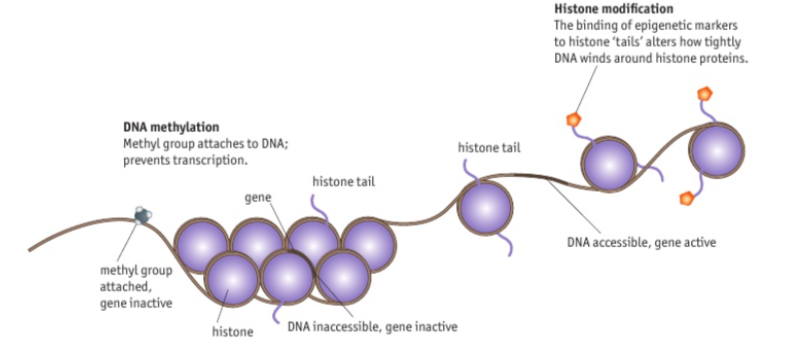
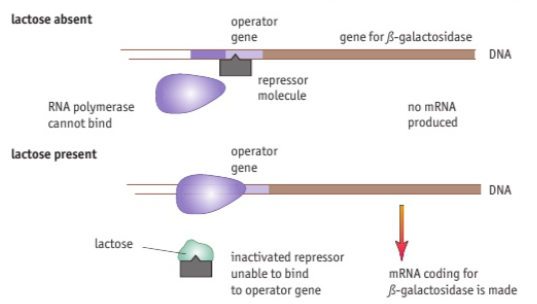
Complete the sentences for the theory for the control of gene expression in the early 1960s:
The French geneticists studies the control of genes in the prokaryote Escherichia coli. These bacteria only produce the enzymes β-glactosidase to break down the c_______ate lactose when it is present in the surrounding medium. This enzyme converts the disaccharide lactose to the _____________ glucose and galactose. When lactose is not present in the environment, a lactose repressor molecules binds to the DNA and prevents the tr________ of the β-glactosidase gene.
The French geneticists studies the control of genes in the prokaryote Escherichia coli. These bacteria only produce the enzymes β-glactosidase to break down the carbohydrate lactose when it is present in the surrounding medium. This enzyme converts the disaccharide lactose to the monosaccharides glucose and galactose. When lactose is not present in the environment, a lactose repressor molecules binds to the DNA and prevents the transcriptio of the β-glactosidase gene.
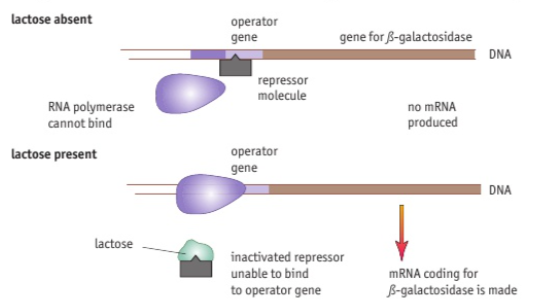
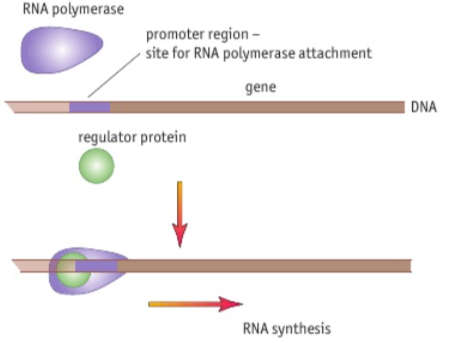
Complete the sentence:
Genes in un______, accessible regions of the eukaryote DNA can be tr________ into mRNA. The enzyme RNA __________ binds to a section of the DNA adjacent to the gene to be transcribed. This section is known as a pr______r region. Only when the enzyme has attached to the DNA will _________ proceed. The attachment of a regulator protein is usually required to ______ transcription.
Genes in uncoiled, accessible regions of the eukaryote DNA can be transcribed into mRNA. The enzyme RNA polymerase binds to a section of the DNA adjacent to the gene to be transcribed. This section is known as a promoter region. Only when the enzyme has attached to the DNA will transcription proceed. The attachment of a regulator protein is usually required to start transcription.
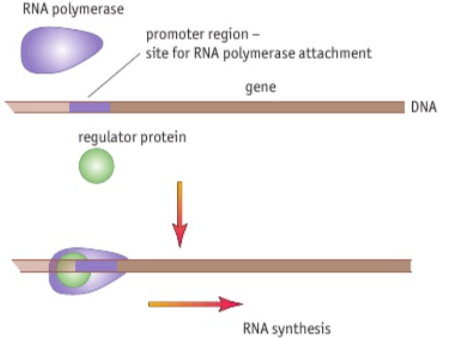
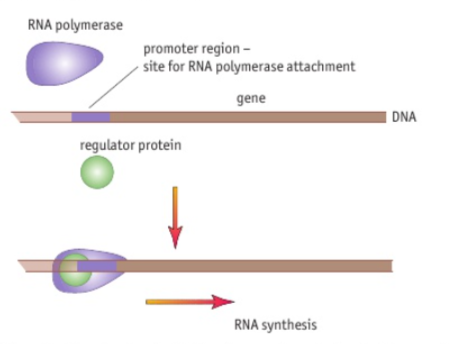
Complete the sentence:
Transcription of a gene can be _________ by protein re_______ molecules attaching to the DNA of the promotor _____, blocking the at_________t site. In addition, protein repressor molecules can ______ to the regulator proteins themselves, _________ them from attaching. In either case, the gene is switched off: it is not t_________ within this cell.
Transcription of a gene can be prevented by protein repressor molecules attaching to the DNA of the promotor region, blocking the attachment site. In addition, protein repressor molecules can attach to the regulator proteins themselves, preventing them from attaching. In either case, the gene is switched off: it is not transcribed within this cell.
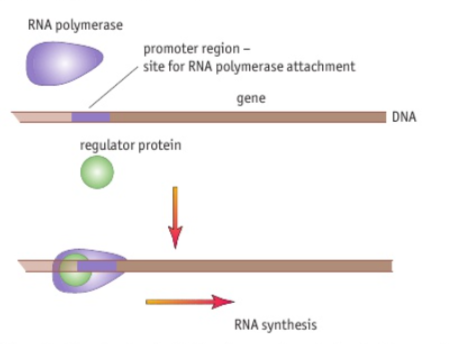
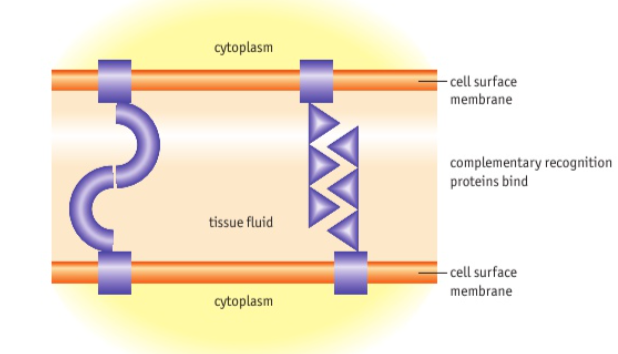
How are cells organised into tissues?
Cells have specific ________ proteins - adhesion molecules, on their cell _____membranes. _______ molecules help cells to recognise other cells like themselves and ____ to them. A small part of each recognition protein is _______ in the cell surface membrane; a larger part _______s from the membrane. This exposed section binds to ____________ proteins on the a_______ cell. The particular recognition _______ synthesised by a cell determine which cells it ___ and _____ attach to. If cells from _________ tissues are separated and then mixed together, they reform into the tissues as the recognition protein ____.
Cells have specific recognition proteins - adhesion molecules, on their cell surface membranes. Adhesion molecules help cells to recognise other cells like themselves and stick to them. A small part of each recognition protein is embedded in the cell surface membrane; a larger part extends from the membrane. This exposed section binds to complementary proteins on the adjacent cell. The particular recognition proteins synthesised by a cell determine which cells it can and cannot attach to. If cells from different tissues are separated and then mixed together, they reform into the tissues as the recognition protein bind.
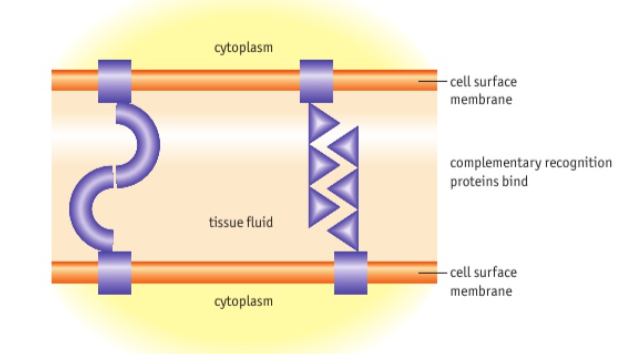
Complete the sentence:
In the human embryo, cells begin to form ______ as they start their s________ functions. At this point, the genes coding for the _________ proteins are switched . Reorganisation of tissues during development occurs through ______ in the type of recognition proteins produced by the cells. In tissues, cells also interact with the extracellular ______, a network of molecules _________ by cells. In some tissues, the extracellular ______ is a major component of the tissue.
In the human embryo, cells begin to form tissues as they start their specialised functions. At this point, the genes coding for the recognition proteins are switched on. Reorganisation of tissues during development occurs through changes in the type of recognition proteins produced by the cells. In tissues, cells also interact with the extracellular matrix, a network of molecules secreted by cells. In some tissues, the extracellular matrix is a major component of the tissue.
What is a tissue?
A group of seciliased cells working together to carry out 1 function
What is an organ?
A group of tissues working together to carry out 1 function
What is an organ system?
A group of organs working together to carry out a particular function
What does the precise sequence of transcription and translation of genes determine?
The sequence of changes during development
Complete the sentences:
During development, epigenetic changes will bring about _________ of the cell. Signals from inside and _______ the cell result in changes to the _________ that alters the genes transcribed at specific times and ________. Copying of the epigenome during DNA replication ensures that the changes occurring during _________ are passed on to new ____.
During development, epigenetic changes will bring about specialisation of the cell. Signals from inside and outside the cell result in changes to the epigenome that alters the genes transcribed at specific times and locations. Copying of the epigenome during DNA replication ensures that the changes occurring during development are passed on to new cells.
What do master genes control?
The development of each segment of the body which becomes specialised
Where are stem cells found in plants?
Meristem tissue
What across the meristem determines which structures will form?
The expression of genes
What determines which type of specialised organ in a plant will be produced in each area of the meristem
Three genes
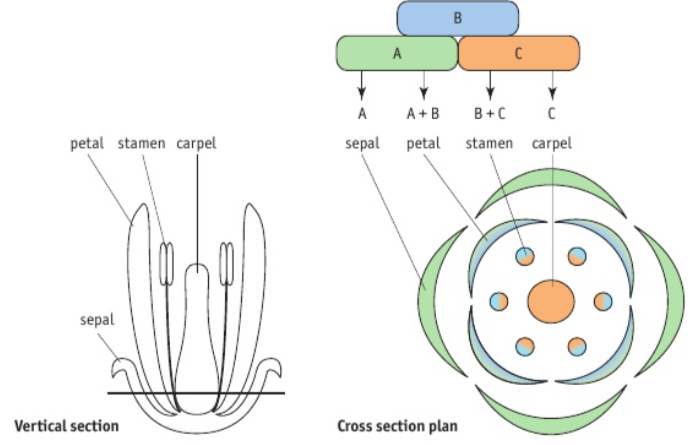
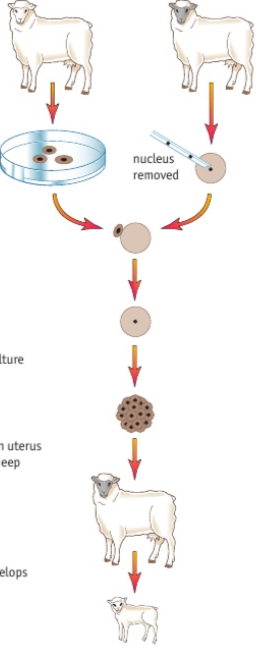
How was dolly the sheep cloned?
The cell donor sheep’s cells were grown in culture. The nucleus was removed from the egg cell of another sheep and the cells were fused- the nucleus from cell donor was inside the egg cell. These cells were grown in culture and implanted in a surrogate sheep. The baby sheep was born and was chromosomally identical to the mammary cell donor.
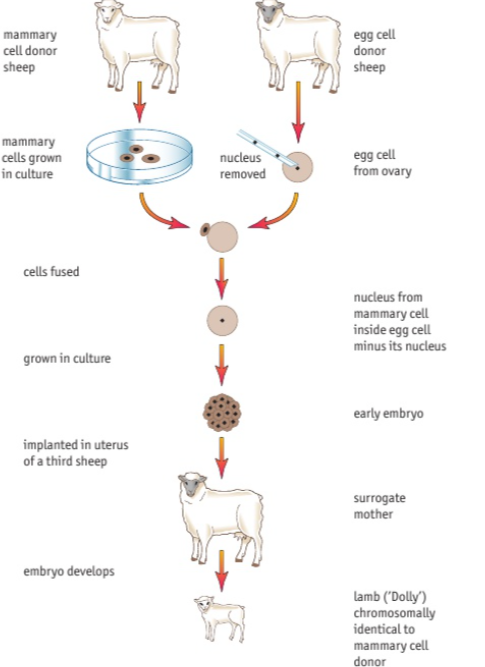
What is a totipotency?
The ability to produce all cell types, including all the specialised cells in an organisms and extraembryonic cells (cells of the placenta and umbilical cord)
What is pluripotency?
The ability of a stem cell to produce all the specialised cells in an organism but not extraembryonic cells, because the genes for these cell types have become inactivated
When are totipotent stem cells present in mammals?
In the first few cell divisions of an embryo after they become plutipotent
Complete the sentences:
Stem cells all contain the same ______, but not all of them are expressed because not all of them are _____. Under the right conditions, some genes are __________ and others are ____________. mRNA is only transcribed from the active genes. The mRNA from the ______ genes is then translated into ________. These proteins modify the ___ they determine cell __________ and control cell _________ (including the activation of more genes, which produces more proteins). Changed to the cell produced by these proteins cause the cell to become specialised (differentiate) These changes are _________ to reverse, so once a cell has speciliased. It stays _______________.
Stem cells all contain the same genes, but not all of them are expressed because not all of them are active. Under the right conditions, some genes are activated and others are inactivated. mRNA is only transcribed from the active genes. The mRNA from the active genes is then translated into proteins. These proteins modify the cellp they determine cell structure and control cell processess (including the activation of more genes, which produces more proteins). Changed to the cell produced by these proteins cause the cell to become specialised (differentiate) These changes are difficult to reverse, so once a cell has speciliased. It stays specialised.
How can gene expression be controlled?
By altering rate of transcription of genes - controlled by transcription factors
What is an activator?
Increases the rate of transcription by helping RNA polymerase bind to DNA and begin transcription
Where do transcription factors bind to in eukaryotes and in prokaryotes?
Eukaryotes - specific DNA sites near start of their target genes (genes they control expression of)
Prokaryotes - operon
What is an operon?
A section of DNA that contains cluster of structural genes that are transcribed together as well as control elements and sometimes a regulatory gene
structural genes code for useful proteins e.g. enzymes
control elements include a promoter, an operator
What is a promoter?
A DNA sequence located before the structural genes that RNA polymerase binds to and
What is an operator?
A DNA sequence that transcription factors bind to
What does the regulatory gene code for?
An activator or repressor
E.coli is a bacterium that respires glucose, but it can use lactose if glucose isn’t available. The genes that produce the enzymes needed to respire lactose are found on an operon called lac operon. lac operon has 3 structural genes lacZ, lacY and lacA, which produce proteins that help the bacteria digest lactose (including Beta-galactosidase and lactose permease)
What happens in lac operon when glucose isn’t present?
The regulatory gene (lacl) produces the lac repressor, which is a transcription factor that binds to the operator site when there is no lactose present. This blocks transcription because RNA polymerase can’t bind to the promotor
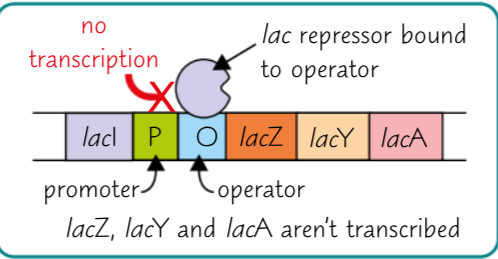
What happens in lac operon when lactose is present?
When lactose is present, it binds to the repressor, changing the repressors’ shape so that it can no longer bind to the operator site. RNA polymerase can now begin transcription of the structural genes.
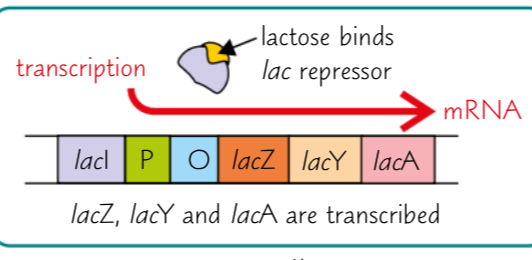
Why are there ethical objections regarding embryonic stem cells?
b/c procedure results in the destruction of an embryo that’s viable (could become a fetus if placed in a womb)
Many people believe that at the moment of fertilisation a genetically unique individual is formed that has the right to life so they believe it is wrong to destroy embryos
Some people have fewer objections to stem cells being obtained from egg cells that haven’t been fertilised by sperm but have been artificially activated to start dividing. This is because the cells couldn’t survive past a few days and wouldn’t produce a fetus if placed in a womb.
What do regulatory authorities do to make a decision about something like embryonic stem cell usage?
look at proposals of research = research done for good reason, not unnecessarily repeated by different groups
licensing and monitoring centres involved in embryonic stem cell research = only fully trained staff carry out research
producing guidelines and codes of practice = all scientists working in a similar manner = comparable results, methods controlled
Monitoring developments in scientific research and advances = any changes in field are regulated appropriately, guideline up to date with latest scientific understanding
providing information + advice to gov + professionals = promotes science involved + helps society understand